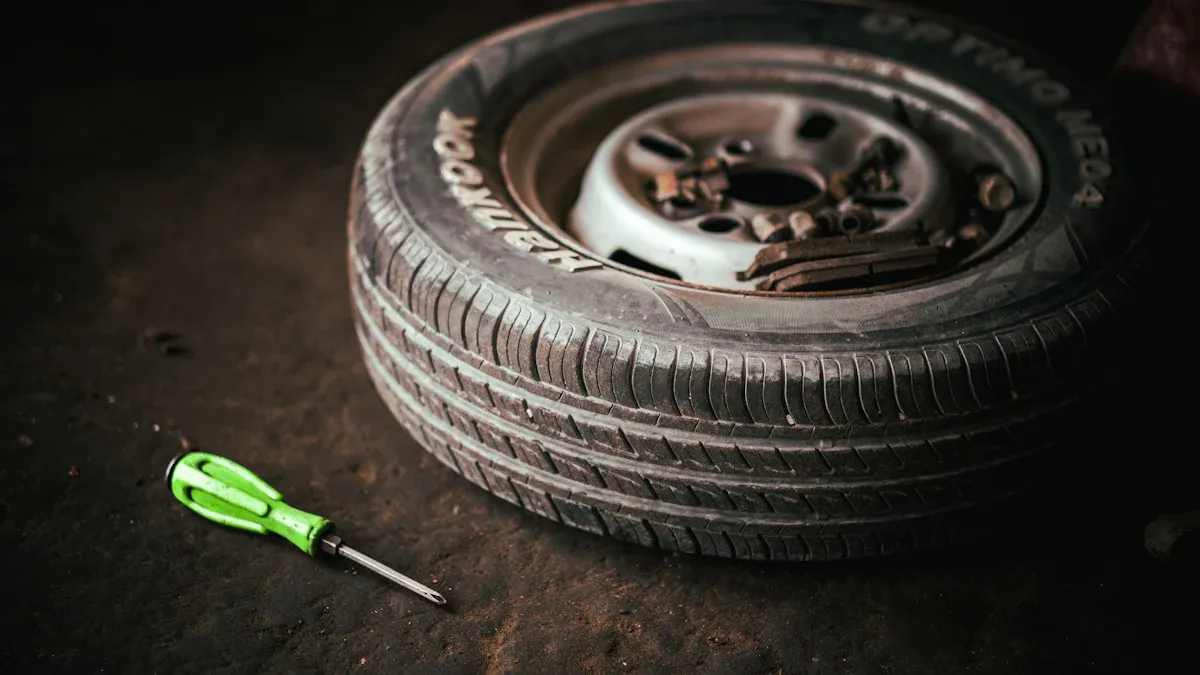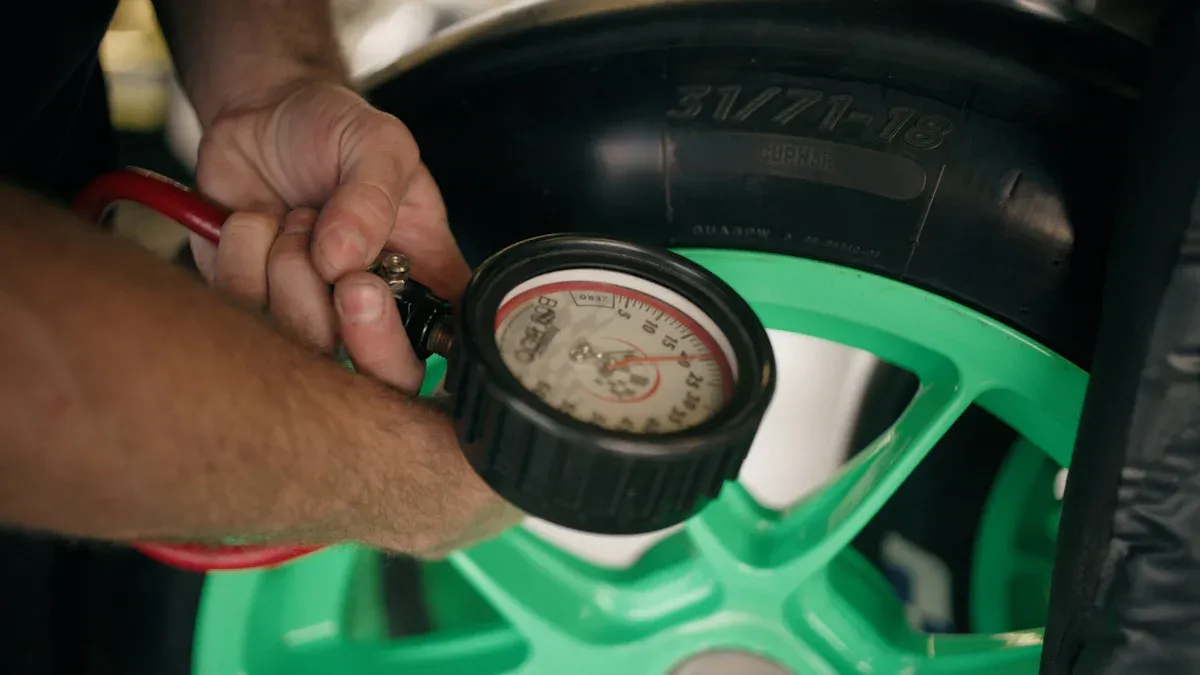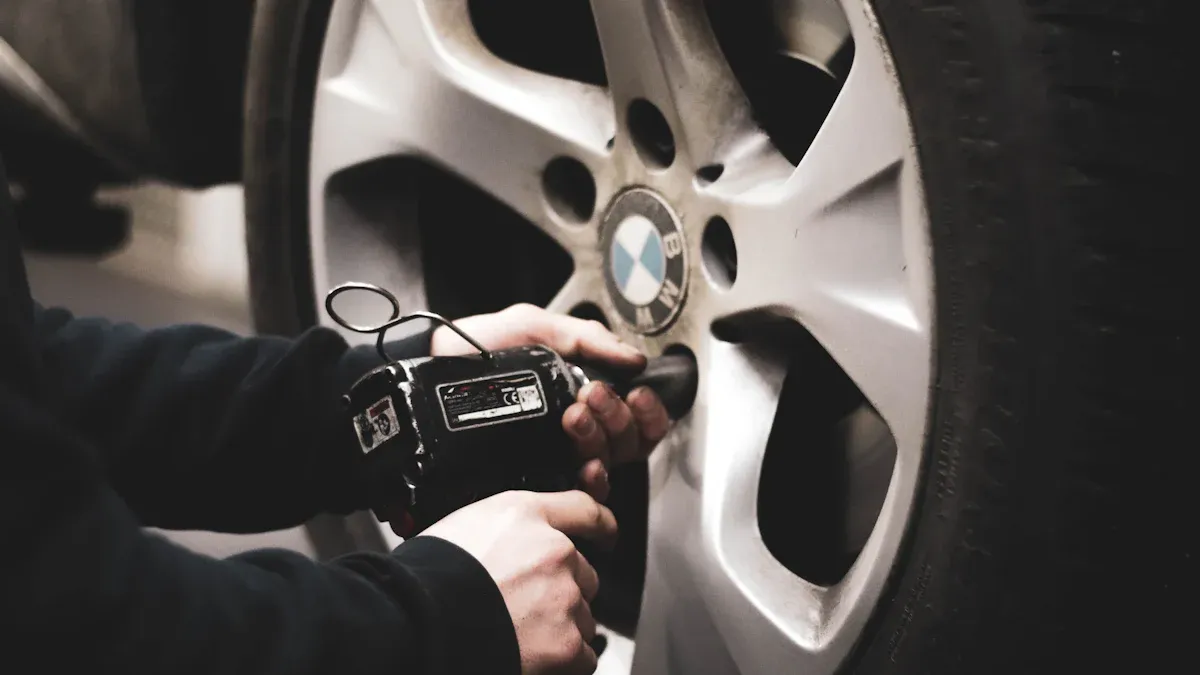

fortuneau
July 14, 2025
Valve Caps and Tire Maintenance: What Every Driver Should Know

You might not notice valve caps every day, but they play a key role in tire maintenance. Valve caps help keep dirt and moisture away from the valve stem, which prevents leakage and supports proper tire pressure. If you leave tire valve caps off, you risk air loss and possible damage to your tires. The importance of valve caps becomes clear when you see how they protect against corrosion and extend tire longevity. By using valve caps, you make sure your tires last longer and stay safe on the road.
Tip: Always check your valve caps when you inspect your tires to avoid unexpected air loss or leakage.
The Significance of Tire Valve Caps

How Valve Caps Prevent Air Leaks
You might think valve caps are just small covers, but they play a big role in preventing air leakage. When you screw a valve cap onto the valve stem, you create a barrier that keeps air inside the tire. This barrier helps stop slow leaks that can happen if dirt or debris gets into the valve. If you drive without caps, you risk losing air over time, which can lead to underinflated tires.
Valve caps also help by sealing the valve stem. This seal is important for preventing air leakage, especially when you drive on rough roads or in bad weather. Even a tiny leak can lower tire pressure and affect how your car handles. By using tire valve caps, you make sure your tires stay at the right pressure for longer periods. This simple step supports efficient tire performance and helps you avoid problems caused by low air.
Note: Always check that your valve caps are tight after filling your tires. A loose or missing cap can lead to slow leakage and lower tire longevity.
Protecting the Valve Stem from Dirt and Moisture
Protecting valve stems from dirt and moisture is another key job of valve caps. When you drive, your tires pick up dust, mud, and water from the road. If this dirt gets into the valve stem, it can cause corrosion or block the valve. Moisture inside the valve can freeze in cold weather, making it hard to add air or causing damage.
Valve caps act as shields for the valve stems. They keep out water and debris, which helps prevent rust and keeps the valve working smoothly. Protecting valve stems in this way means you avoid costly repairs and keep your tires in good shape. You also reduce the risk of sudden air loss, which can happen if the valve gets clogged or damaged.
- Valve caps help by:
- Blocking dirt and sand from entering the valve stem.
- Stopping water from causing rust or corrosion.
- Making sure the valve stays clean and easy to use.
By protecting valve stems, you help your tires last longer and keep your car safe on the road.
Supporting Tire Pressure and Safety
Maintaining proper tire pressure is one of the most important parts of tire safety. Valve caps support this by preventing air leakage and protecting valve stems from damage. When you keep your tires at the right pressure, you improve tire performance and make your car safer to drive.
Most passenger vehicles need tire pressure between 30 and 35 psi. If your tires have too little air, they wear out faster, handle poorly, and take longer to stop. Underinflated tires cause about 40% of unexpected tire failures, which can lead to accidents. Overinflated tires also cause problems, like faster wear in the center of the tread and a rougher ride.
Valve caps help you keep the right pressure by stopping slow leaks and protecting valve stems. This means you get better handling, more even tire wear, and longer tire life. You also lower your risk of blowouts and accidents. Tire Pressure Monitoring Systems (TPMS) can warn you if your pressure drops, but valve caps give you extra protection by preventing air loss in the first place.
Tip: Check your tire pressure at least once a month and before long trips. Make sure your valve caps are always in place to help maintain proper tire pressure and support tire safety.
The significance of tire valve caps goes beyond just covering the valve. By preventing air leakage, protecting valve stems, and supporting proper tire pressure, you help your tires last longer and keep your vehicle safe. Paying attention to these small parts can make a big difference in your driving experience and safety.
Types and Materials of Valve Caps

When you choose valve caps, you will find several types and materials. Each option offers unique benefits for your vehicle. Understanding these differences helps you make the best choice for your driving needs.
Plastic Tire Valve Caps
Plastic tire valve caps are the most common type you will see on cars today. They are lightweight and cost-effective. Many drivers prefer them because they are easy to remove and replace. Plastic caps resist corrosion, so you do not have to worry about them sticking to the valve stem, even in wet or salty conditions. Some plastic caps include an interior sealing ring, which helps prevent moisture from reaching the valve core. This feature protects against rust and makes maintenance easier.
You can see how plastic compares to other materials in the table below:
| Material | Durability & Environmental Resistance | Advantages | Limitations | Typical Applications |
|---|---|---|---|---|
| Plastic | Good, with ongoing improvements | Lightweight, affordable, easy to use | Less strong in extreme conditions | Most cars, daily driving |
| Metal | High, especially in tough settings | Strong, durable, stylish | Can corrode, heavier, higher cost | Trucks, performance vehicles |
| Rubber | Flexible, chemical resistant | Seals well, resilient | Less durable over time | Valve stems, washers |
Tip: If you drive in areas with lots of rain or snow, plastic tire valve caps can help prevent corrosion and make tire checks easier.
Metal Tire Valve Caps
Metal valve caps offer extra strength and a premium look. You might choose them for their durability, especially if you drive in harsh conditions or want a stylish upgrade. Metal caps often include rubber washers or o-rings for a better seal. This helps keep air inside and blocks dirt and water. However, metal caps can corrode if exposed to moisture or road salt. In cold or humid climates, they may seize onto the valve stem, making removal difficult. Some drivers use anti-seize compounds to avoid this problem.
Here are some key points about metal valve caps:
- They provide strong protection and resist physical damage.
- They may corrode and stick to the valve stem in wet or salty environments.
- Regular removal and cleaning can help prevent seizing.
If you want a cap that lasts and looks great, metal is a solid choice. Just remember to check them often, especially in winter.
Specialty and Colored Valve Caps
Specialized tire valve caps go beyond basic protection. You can find caps with built-in pressure indicators that show when your tire pressure drops. Some have anti-theft features, like locking mechanisms, to keep your caps secure. Others include tools for removing valve cores or even LED lights for better visibility at night.
Colored valve caps serve both functional and personal style needs. For example:
- Green caps show that your tires use nitrogen, which helps keep pressure stable.
- Red caps warn technicians that your tires have balancing beads inside.
- Bright colors make it easy to spot missing caps or match your car’s look.
The importance of valve cap colors stands out in busy shops, where technicians need quick visual cues. Specialty and colored caps use materials like aluminum, brass, or titanium, and often feature polished or anodized finishes for extra durability and style. You can even find custom engravings or logos for a unique touch.
Note: Specialized tire valve caps help you maintain tire pressure, protect against theft, and add a personal touch to your vehicle.
Installation and Replacement of Valve Caps
Proper Installation Steps
You can keep your tires safe by following the right steps for installing valve caps. Proper installation helps prevent air leakage and keeps dirt out of the valve stem. Here is a simple guide you can follow:
- Always start with clean hands and a clean valve stem. Wipe away any dirt or debris using a lint-free cloth.
- Check the valve stem for cracks or damaged threads. Replace the stem if you see any problems.
- Choose high-quality valve caps that fit your valve stem well.
- After inflating your tire, screw the valve cap on by hand. Turn it until it feels snug, but do not use too much force.
- Avoid over-tightening. Too much pressure can damage the threads or the seal.
- Inspect the cap to make sure it sits straight and covers the valve stem completely.
Tip: Use a professional valve installation tool if you want to ensure the cap is seated perfectly. This tool helps you avoid cross-threading and keeps the seal tight.
When to Replace Valve Caps
You should replace valve caps whenever you notice damage or loss. Experts do not recommend a fixed schedule for replacement. Instead, focus on the condition of each cap. Damaged or missing caps can let air escape and allow dirt or moisture into the valve. This can lead to slow leaks and even tire failure.
- Replace valve caps if you see cracks, brittleness, or if they no longer fit tightly.
- Always install new caps after buying new tires or valve stems.
- If you lose a cap, put on a new one right away to prevent contamination.
Note: Regular inspection during tire maintenance helps you catch problems early and avoid unexpected air loss.
Identifying Damaged or Missing Valve Caps
You can spot damaged or missing valve caps with a quick visual check. Look for cracks, loose-fitting caps, or missing pieces. If you hear a hissing sound near the valve stem, you may have a leak. Try spraying soapy water on the valve area. Bubbles mean air is escaping, which signals a problem.
- Lift your vehicle to see all valve caps easily.
- Remove each cap gently. If it sticks, use a little lubricant or pliers.
- Check inside the cap and the valve stem for dirt or corrosion.
- Clean away any debris and replace worn or missing caps right away.
A missing or damaged cap exposes the valve to dirt and moisture. This can cause leaks and damage the valve core. By checking your valve caps often, you help keep your tires in top shape and avoid trouble on the road.
Choosing the Right Valve Caps for Your Vehicle
Matching Valve Caps to Vehicle Type
You need to match valve caps to your vehicle for the best results. Each type of vehicle has different needs. When you choose valve caps, think about these factors:
- Material: Plastic caps work well for most cars because they are light and affordable. Metal caps are better for trucks and motorcycles since they last longer and handle rough use.
- Style: You can pick from simple dome-shaped caps or choose decorative ones to match your vehicle’s look.
- Tightening Mechanism: Look for caps with a secure grip. This helps you tighten them easily and keeps the seal strong.
- Weather Resistance: Choose caps that protect against dust, dirt, and harsh weather.
- Versatility: Some valve caps fit many types of vehicles, including cars, trucks, motorcycles, and even bicycles.
- Bulk Ordering: If you have more than one vehicle, buying in bulk saves money and gives you spares.
- Functional Role: Valve caps keep tire pressure steady and protect valve stems from damage.
For high-performance or off-road vehicles, you may need special designs. The table below shows which valve caps work best for different vehicles:
| Valve Cap Type | Recommended For | Reason for Recommendation |
|---|---|---|
| Metal Valve Caps | Sports cars, race cars, high-speed | Withstand high temperatures; tight seal with rubber washers |
| Heavy-Duty Aluminum Caps | Off-road vehicles | Resist cracks and dents; seal out dust, sand, and water |
| High-Pressure Snap-In Valves | Heavy-duty trucks, rugged light trucks | Handle high pressure; provide durability and reliability |
Considering Driving and Weather Conditions
Your driving environment affects how valve caps perform. Extreme heat can change the way seals and hoses work, making them less resistant to tearing and leaks. Cold weather can cause seals to shrink and harden, which may lead to air leaks. If you drive in places with lots of rain, snow, or humidity, you need caps that resist corrosion and keep out moisture.
- Metal valve caps, especially aluminum, last longer in harsh weather than plastic ones.
- Weather-resistant caps protect valve stems from dirt, debris, and water.
- These caps help maintain tire pressure and prevent leaks, even in extreme heat or cold.
If you use nitrogen-filled tires, you may notice green valve caps. These caps help you and your mechanic spot which tires use nitrogen, making maintenance easier.
Tips for Selecting Quality Valve Caps
You want valve caps that last and keep your tires safe. Look for these quality indicators:
- Material: Metal caps, like aluminum or stainless steel, offer better durability and a stronger seal than plastic, especially in tough conditions.
- Features: Some caps have rubber seals for extra protection. Others include pressure indicators or LED lights for added safety.
- Compatibility: Make sure the caps fit your tire valve stems. Most are universal, but always check before buying.
- Quality: Pick high-quality caps that seal well and stand up to road and weather challenges.
- Maintenance: Install your caps properly and check them often to keep them working well.
If you have nitrogen-filled tires, always use the correct colored cap to avoid confusion during service.
Tip: Regularly inspect your valve caps for cracks or looseness. Replace them right away if you see any problems.
You play a key role in keeping your vehicle safe by checking valve caps often. When you use quality valve caps, you help protect tire valves from dirt and moisture. This simple habit keeps proper tire pressure, which improves fuel efficiency and reduces tire wear. Regular checks lower the risk of flat tires and costly repairs. Many drivers in the trucking industry rely on durable valve caps to avoid downtime and keep their vehicles running smoothly.
Quick Checklist:
- Inspect valve caps during every tire check.
- Replace any missing or damaged caps immediately.
- Choose the right type and material for your vehicle and driving conditions.
FAQ
What happens if you drive without valve caps?
You risk dirt and moisture entering the valve stem. This can cause slow air leaks and corrosion. Your tires may lose pressure faster, which can lead to uneven wear or even a flat tire.
How often should you check your valve caps?
Check your valve caps every time you inspect your tires. Most experts recommend a monthly tire check. Always look for missing or damaged caps before long trips.
Can you use any valve cap on any vehicle?
Most valve caps fit standard Schrader valves found on cars, trucks, and bikes. Some specialty vehicles may use different valves. Always check your vehicle’s manual if you are unsure.
Do colored valve caps have a special meaning?
Yes. Green caps often show nitrogen-filled tires. Red or blue caps may signal special tire features. Always ask your service technician if you see colored caps you do not recognize.





